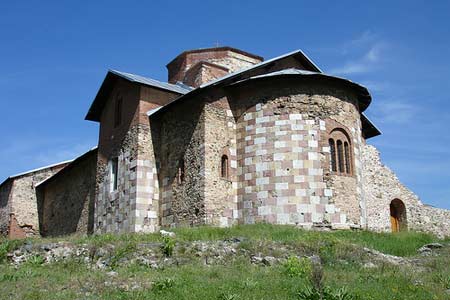Tronosa monastery is located in the central part of Serbia, in Macva District, near Trsic village.
 |
| Queen Katalina |
According to legend, King Dragutin started building the monastery, but he died during its construction. Therefore his wife, Queen Katalina, finished it in 1317. However, in the Tronosa Chronicle from 1791, only Dragutin’s wife is mentioned as the founder of the monastery.
The church of Tronosa monastery is dedicated to the Presentation of the Virgin Mary, and is a single nave building built in 1559 in the Raska architectural style. The Iconostasis was painted in 1834 by Nikola Jankovic, the 19th century church painter, who painted all the icons except two which were done in 1866. The monastery was consecrated in 1834.
 Today’s monastery complex consists of: a church, new quarters with a spacious dining room, an exhibition room, and a museum dedicated to Vuk Stefanovic Karadzic (Serbian linguist and major reformer of the Serbian language) who was educated in this monastery from 1797.
Today’s monastery complex consists of: a church, new quarters with a spacious dining room, an exhibition room, and a museum dedicated to Vuk Stefanovic Karadzic (Serbian linguist and major reformer of the Serbian language) who was educated in this monastery from 1797. There is a concrete fountain not far from the monastery, built (according to legend) by Jug Bogdan and the nine brothers Jugovic before heading to the Battle of Kosovo. Above the fountain there is a chapel dedicated to St. Panteleimon. It was rebuilt by Archimandrite Metodije and a merchant from Lesnica, Mladen Isakovic, in 1894. The last renewal of the chapel and the fountain was done by Bishop Jovan and the Prior of Tronosa, Antonije Djurdjevic. On the exterior of the chapel, above the water pipe, there’s a mosaic representing the nine Jugovic brothers with Jug Bogdan in the middle, all on their horses heading to the battle of Kosovo.
| Chapel with a fountain |
The monastery played an important part in the preservation of Serbian culture and tradition.
Prior Jovan formed a copying school in the monastery, where between 1571 and 1581 service books for Tronosa and other nearby monasteries were copied, thus preserving the historical and cultural documents of Serbia.
 One of the most beautiful folk customs connected to Tronosa monastery are the so-called Cropping Candles. Two nearby villages collect contributions of wax and money in order to make candles 2m high and weighing over 50kg.
One of the most beautiful folk customs connected to Tronosa monastery are the so-called Cropping Candles. Two nearby villages collect contributions of wax and money in order to make candles 2m high and weighing over 50kg.During the Turkish period, Tronosa was burnt, demolished and pillaged several times. It was rebuilt in 1559. The monastery was burnt again in 1813, and restored in 1833 thanks to Prince Milos Obrenovic.
During the First and Second Serbian uprising, Tronosa was a meeting place of the uprisings leaders. In WWI a hospital was improvised in the monastery for the wounded. The last demolition of Tronosa was at the beginning of WWII, when besides major damage to the building, valuable manuscripts and objects from the treasury were destroyed. After WWII the church was restored between 1964 and 1987, during the festivities dedicated to Vuk Karadzic.











